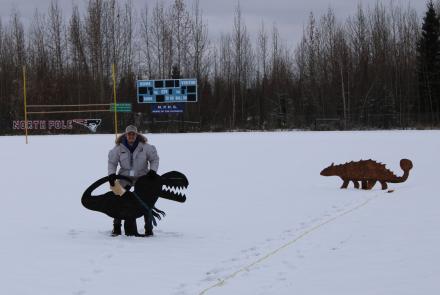Meet graduate student researcher Sebin John
Graduate student researchers are the future of science and an integral part of our Geophysical Institute family.
So let’s meet some of them.
Here’s Sebin John from the GI’s Seismology and Geodesy Research Group. His advisor is research professor Mike West, director of the Alaska Earthquake Center.
Q: Where are you from? Tell us about that place.
Sebin: I was born and brought up in a small village in southern India. It is a lush green place with nice pleasant weather since it is up in the hills. There are a lot of rivers and waterfalls. My village is nestled between two big mountains on either side. It is not uncommon for us to see herds of elephants while we hike these hills.
Q: Tell us about your education path. Where were you before coming to UAF? What stage are you at in your graduate program?
Sebin: I did all of my schooling in the government schools in the village itself. Then I did a bachelor's in physics from a college in one of the modest towns nearby. Later, I moved to Kochi, the largest city in the state, and did a master’s in marine geophysics. Then I moved to Hyderabad, a big city, and interned at a national research institute. I worked on earthquakes in the Himalayas during that time. Currently, I am a fourth-year Ph.D. student working at the Alaska Earthquake Center.
Q: Tell us about your general field of research. What do you find interesting about it?
Sebin: Did you know that the ground beneath our feet is constantly shaking, even when there's no earthquake? These subtle vibrations are called microseisms, and they’re primarily generated by ocean storms. They’re too faint for humans to feel, but a highly sensitive instrument like a seismometer can detect them.
While many seismologists consider these signals as noise when studying earthquakes, I see them differently. For me, they’re quite valuable. These microseisms carry rich information about the interactions between the ocean, atmosphere and solid Earth. Understanding how these systems couple and influence each other is actually seen as one of the next grand challenges in seismology — and that’s what excites me. I believe these vibrations offer us a powerful, underutilized way to learn more about our planet.
Q: What are you working on now?
Sebin: I am working on glacial quakes produced by the Columbia Glacier located in southern Alaska. A slightly different project, but it fits nicely with the general environmental seismology theme.
Q: Why did you choose UAF?
Sebin: I was looking for projects that either investigate climate change or the deep interior Earth. Mike West at the Alaska Earthquake Center had an interesting project to study climate change in Alaska, focusing specifically on the Arctic. That fit well with my aspirations, and that's why I chose UAF.
Q: What do you like most about doing research at the UAF Geophysical Institute?
Sebin: The Earthquake Center operates around 500 seismic stations across Alaska, which is no small feat given how remote much of the state is. Alaska is also the most seismically active state in the U.S., which makes this work incredibly important. These factors attract talented, interesting and genuinely kind people from all over the world. It’s been a lot of fun — and really rewarding — to work alongside them.
Q: What do you do outside of UAF? What would you tell someone about things to do in Fairbanks?
Sebin: Outside of UAF, I enjoy playing badminton and going on sightseeing trips. I’ve also been learning to play the piano, which has been a fun challenge. And when I have some down time, I like to unwind with movies or storyline-based video games.
Q: What do you hope to be doing when you complete your graduate degree?
Sebin: That's a good question, and I don’t have a clear answer. I am interested in industry if my day-to-day job involves doing research that matters to the world. I love academics, too. I want to say I don’t know.
Q: Anything else you’d like to add?
Sebin: Thanks for having me. It is great to talk with you
• Rod Boyce, University of Alaska Fairbanks Geophysical Institute, 907-474-7185, rcboyce@alaska.edu




